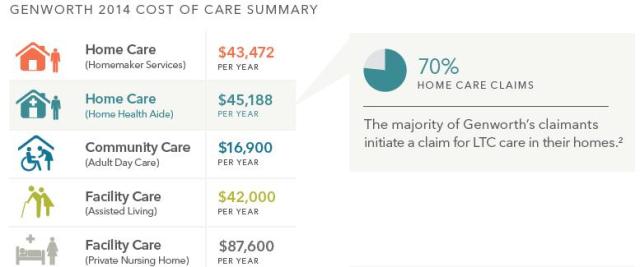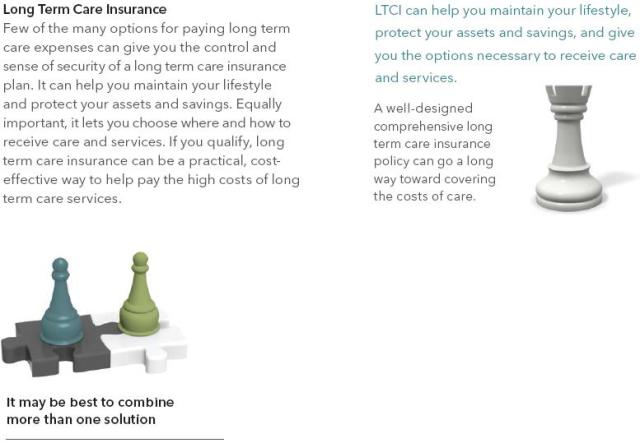Have you ever wondered why nursing home residents are primarily women, and why they never seem to have visitors?
Data confirms this, according to the Centers for Disease Control and Prevention (CDC). Of the roughly 1.4 million nursing home residents in 2013, about 67.7 percent — or roughly 960,000 — were women. The question that should be asked is: How did it get this way?
Yes, it is understandable that women tend to outlive men in general. The CDC is reporting that the average life expectancy for a person who was 65 years old in 2012 is another 19.3 years: 20.5 years for women, and 17.9 years for men. Is the fact merely that they live longer the primary reason why women tend to make up the vast majority of residents in nursing facilities, or are there other factors at play?

Just ask Michael Gerali, co-author of “What You Don’t Know About Retirement Will Hurt You.” He has stated numerous times that one of the main factors as to why women make up the bulk of residents in nursing facilities is how we as a nation plan (or, rather, don’t plan) for retirement. “The problem isn’t how we accumulate assets. It’s how we distribute them, along with the advice we receive to never insure certain aspects of life, and tying up the equity of our homes that are a few of the main driving forces behind this,” Gerali says.
“As we prepare for retirement, the oft-given advice is to plow as much money into our employer retirement plans as possible, and that we should take advantage of traditional or tax-deferred investments, along with forgetting about insurance, as well. Ergo, they buy term and invest the difference.”
To get a clearer picture of what Mr. Gerali is saying, let’s take a typical couple, “John and Mary,” who want to retire at age 67 or as soon as they can in order to enjoy their lives on their own terms. They have been told for years to invest as much as they can afford into the stock market, as that tends to generate the highest rates of return over time. This is usually done by taking advantage of their employer’s 401(k) or 403(b).
They are also told to buy term insurance while their kids are still home in order to protect the family and any income needs they have, since it just happens to be the cheapest way to obtain that coverage. Other popular advice is to take advantage of Roth accounts if available, as well as to pay down as much debt as possible. The goal is to hopefully live debt-free in retirement — and with the mortgage paid in full, John and Mary will be able to pass their home to their children if they so choose.
 In their first 10 to 15 years of retirement, everything is going great. They are experiencing everything they could possibly have ever dreamed of. Yes, there have been some bumps along the way, and there have been a lot of unexpected expenses, but they have weathered every storm and once again, it’s smooth sailing. Unfortunately, one day, John happens to get sick, and this time the illness is far worse than just a severe cold: it may be a chronic ailment that is robbing him of the ability to walk or eat. It could even be something as serious as cancer or cardiovascular disease. Either way, John’s health is deteriorating and Mary is now faced with another obstacle that they both have to overcome.
In their first 10 to 15 years of retirement, everything is going great. They are experiencing everything they could possibly have ever dreamed of. Yes, there have been some bumps along the way, and there have been a lot of unexpected expenses, but they have weathered every storm and once again, it’s smooth sailing. Unfortunately, one day, John happens to get sick, and this time the illness is far worse than just a severe cold: it may be a chronic ailment that is robbing him of the ability to walk or eat. It could even be something as serious as cancer or cardiovascular disease. Either way, John’s health is deteriorating and Mary is now faced with another obstacle that they both have to overcome.
Mary, like any loving spouse would do, decides that she will take care of John and his rapidly deteriorating health as her husband does his best to still be active and contribute, because there is no way that John, in his mind, can’t overcome this. As Mary sets her retirement plans aside and begins her new role as caregiver and nurse, the added physical and mental stresses begins to take a toll on her own health. As she is spending all of her time tending to her husband, she is not focusing on her own needs, her diet or getting proper sleep. Even the daily routines of paying bills and general upkeep of the house take a backseat to the care and attention that John requires.
And this is where the real problem raises its ugly head: Mary is not well-versed in household finances, seeing as John was the one who made the big financial decisions. Yes, Mary most likely paid the bills, ran the budget, and gave John an allowance each week, but the long-term investments that they built typically fell under John’s responsibility. Mary is now stuck in the situation of not really knowing what to do, and like any smart person, she seeks advice from their trusted financial advisor.
Their advisor does do his/her best to help. She gives Mary the typical advice that almost every “Mary” receives in times of crisis:
- Take a tally of all your investments
- Find any accounts, wills, trusts and deeds that you may have
- Create a distribution plan that will best suit the needs of Mary and John, while mitigating any tax consequence they may face
This distribution plan will mostly unfold as follows: First, distribute any cash, then move to
liquid investments like stocks and/or bonds, then Roth IRAs, and finally tax-deferred accounts like IRAs and rollover 401(k) accounts. The rationale is to use what is taxed today and leave any investments that are tax-deferred for later, as this will allow them to grow even more while delaying any tax consequence.
So as Mary heeds this advice, she first uses the cash, then any stocks or bonds that they may have, and as John’s health is worsening and the liquid assets have been depleted, she is now faced with using either their Roth accounts or traditional IRAs like their 401(k) plans.

John unfortunately passes away, and to Mary’s horror, she finds that after all of that financial advice, there really isn’t any life insurance on John, as they both decided to buy term insurance and invest the difference. So Mary now has a larger problem:
- Her health is deteriorating.
- She is now receiving even less Social Security, as John has passed away and his benefit has ceased.
- She still has all of her current bills: water, electric, property taxes, groceries, etc.
- She does have those tax-deferred accounts, as she did save those instead of the others, but is now in a different tax and Medicare bracket, which means every withdrawal will increase her tax liability and possibly her Medicare premiums, as well.
- She also has the house, but with John now gone and her no longer working, she is in the predicament of not being able to tap any equity from her home.
Mary is now in the position of having to use even more of the assets in those tax-deferred accounts to help pay for her well being and her home, but each time she makes a withdrawal, she is in the unfortunate position of being in a higher tax bracket and a lower Medicare income bracket. Those withdrawals are now being taxed as ordinary income by the IRS; she no longer has any write-offs since the house is paid for; the children are gone; and by being single, her tax bracket has changed, as well.
 Not only is the goal to delay paying the government now starting to backfire on Mary, but to top it off, Medicare is also counting those withdrawals as income. So instead of being in a Medicare income bracket of $170,000 as a couple with John, her new Medicare tax bracket is lowered by half, with her new limit being only $85,000. This is leading to even higher Medicare premiums, which is leading to less Social Security income, which is leading her to withdraw even more money from those tax-deferred accounts, and on and on…
Not only is the goal to delay paying the government now starting to backfire on Mary, but to top it off, Medicare is also counting those withdrawals as income. So instead of being in a Medicare income bracket of $170,000 as a couple with John, her new Medicare tax bracket is lowered by half, with her new limit being only $85,000. This is leading to even higher Medicare premiums, which is leading to less Social Security income, which is leading her to withdraw even more money from those tax-deferred accounts, and on and on…
The vicious cycle has now begun for Mary. Towards the end, Mary is bleeding assets in every direction, and just staying in the house is becoming next to impossible. Her only choice? A nursing home. Her dream of living in her own home until the end, and leaving her children with something in terms of assets, is over. She is now faced with having to try to qualify for Medicaid, which means she will most likely have to give away any assets she has left (including her home) and hope that there will be a nursing home somewhere in the vicinity of her family that not only has an opening, but also accepts someone with only Medicaid, since she has no way to pay for herself.
Does Mary have any choices left? Does this story sound in any way familiar? Is there a woman going through this right now (and yes, it could be a man, but at a much lower percentage)? Well, it doesn’t have to, and it doesn’t have to happen to any more Marys or Johns. All that is needed is a simple revamp of distribution with something everyone should have in one form or another: long-term care, some permanent life insurance and a possible reverse mortgage, all coupled with a much different income distribution plan. With these, the ending for Mary is quite different.
By just changing the distribution of those assets, along with a couple minor adjustments to their financial plan, and having the equity from their home still be available, the story could simply be: Before entering retirement, John and Mary speak with a financial advisor who places some of their investments into a standalone long-term care insurance policy, or a “hybrid” policy. Or it could even be something as simple as an annuity or life insurance product that has some form of an LTC insurance rider which will allow them to tap some monies for care.
They investigate a reverse mortgage where they can take the equity out of their home when they want. Yes, they may lose the house in the end, but Mary does have the option to stay there for the rest of her life. Do their adult children really want to inherit another home they then have to pay taxes on, along with the other bills and responsibilities associated with owning a second home?
Some permanent life insurance is purchased on both of their lives — nothing grand, but enough to supplement any lost Social Security benefits if one of them passes away before the other. Finally, they start using those tax-deferred accounts first while they are younger, healthier and in a higher Medicare and income tax bracket. They also look into possibly converting some of those traditional IRA/401(k) assets to Roths, as Roths are much more friendly to both health costs and tax obligations.

If John does finally get sick, instead of using the cash first, they opt to deplete those tax-deferred accounts instead. They then move to those investments such as stocks and bonds. Remember, John and Mary each have some form of LTC, so Mary can afford to have professional care brought into the home for John so she can maintain her lifestyle and her health. When John does finally pass away, Mary is still in the position of having less Social Security (as she can only receive the higher of the two benefits), but that life insurance policy helps offset the loss of income.
She also has the ability to tap the equity from her home with that reverse mortgage, along with the right to live there, along with also having some form of long-term care coverage, the cash she never spent, and hopefully those Roth IRAs. By the way, those Roth IRAs, long-term care benefits, and the equity from her home are not considered as income by the IRS (or even Medicare for that matter), so her tax bill is lower and her Medicare premiums are standard.
Mary now has options. She has the choice to stay at home, hire someone to take care of her, and have the means to make any changes to her house to fit her current health situation. She also has the opportunity to become a resident at a nursing facility if she so desires, since she will most likely have the means to afford that care.
What is currently happening to women near the end of their lives — living in a nursing facility, alone and broke — doesn’t have to happen. All that is needed is a decent understanding of what really happens in retirement to those who don’t plan accordingly.
About the Author

Dan McGrath
Dan McGrath, author of “What you don’t know about retirement will hurt you!” is one of the country’s leading experts on how the high costs associated to healthcare will impact retirement, Social Security and the overall economy. Mr. McGrath is the Co-Founder of Jester Financial.
Article available through Jester Financial










 In their first 10 to 15 years of retirement, everything is going great. They are experiencing everything they could possibly have ever dreamed of. Yes, there have been some bumps along the way, and there have been a lot of unexpected expenses, but they have weathered every storm and once again, it’s smooth sailing. Unfortunately, one day, John happens to get sick, and this time the illness is far worse than just a severe cold: it may be a chronic ailment that is robbing him of the ability to walk or eat. It could even be something as serious as cancer or cardiovascular disease. Either way, John’s health is deteriorating and Mary is now faced with another obstacle that they both have to overcome.
In their first 10 to 15 years of retirement, everything is going great. They are experiencing everything they could possibly have ever dreamed of. Yes, there have been some bumps along the way, and there have been a lot of unexpected expenses, but they have weathered every storm and once again, it’s smooth sailing. Unfortunately, one day, John happens to get sick, and this time the illness is far worse than just a severe cold: it may be a chronic ailment that is robbing him of the ability to walk or eat. It could even be something as serious as cancer or cardiovascular disease. Either way, John’s health is deteriorating and Mary is now faced with another obstacle that they both have to overcome.
 Not only is the goal to delay paying the government now starting to backfire on Mary, but to top it off, Medicare is also counting those withdrawals as income. So instead of being in a Medicare income bracket of $170,000 as a couple with John, her new Medicare tax bracket is lowered by half, with her new limit being only $85,000. This is leading to even higher Medicare premiums, which is leading to less Social Security income, which is leading her to withdraw even more money from those tax-deferred accounts, and on and on…
Not only is the goal to delay paying the government now starting to backfire on Mary, but to top it off, Medicare is also counting those withdrawals as income. So instead of being in a Medicare income bracket of $170,000 as a couple with John, her new Medicare tax bracket is lowered by half, with her new limit being only $85,000. This is leading to even higher Medicare premiums, which is leading to less Social Security income, which is leading her to withdraw even more money from those tax-deferred accounts, and on and on…
















 Spouses and extended family members of employees are encouraged to participate in employer-sponsored long-term care benefit programs. Currently, more than 22 million Americans provide care for a spouse, family member over the age of 50. By the end of the decade, 1 in 10 workers will be a full- or part-time caregiver.
Spouses and extended family members of employees are encouraged to participate in employer-sponsored long-term care benefit programs. Currently, more than 22 million Americans provide care for a spouse, family member over the age of 50. By the end of the decade, 1 in 10 workers will be a full- or part-time caregiver.